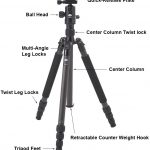If you’re looking for a linear shaft and don’t know where to start, this guide is for you. In it, we’ll cover what a linear shaft is, how it works and the different types available. We’ll also discuss some factors that can affect your choice of the linear shaft for your application.
What is a Linear Shaft?
You may have noticed linear shafts when you were working with a machine. They are the straight rods that support your load, and they can be made of metal, plastic, or wood. Linear shafts are used in a variety of applications in industries like manufacturing and automation.
The most common application for linear shafts is an actuator assembly system that converts rotational motion into linear motion. This conversion allows the use of simple motors as well as complex motorized systems without requiring any additional components such as gears or pulleys.
The Different Types of Linear Shafts
- The straight shaft is the most common type of linear shaft, and it’s often used for precision applications. The length of a straight shaft can be altered depending on how much you need to extend your application’s range of motion.
- A curved shaft is similar to a straight one in that it also extends when you turn it, but the difference between them lies in their shape curved ones are bent at an angle from left to right or vice versa while straights are just straight. Curved ones are often used when an object needs to move forward yet remain parallel with something else (like if you wanted your desk lamp’s arm to reach farther).
- Tapered/taper-cut linear shafts have tapered ends instead of flat ones. They’re good for applications where small changes matter more than large ones because they offer greater accuracy and control over how far things can go before hitting their limits (e.g., machines used by doctors).
Factors to Consider When Choosing a Linear Shaft
When you’re choosing a linear shaft, there are several factors you should consider.
- The type of application: Linear shafts are used in a variety of applications and will have different needs depending on the equipment they’re being used with. For example, if you’re looking at using a linear shaft in an industrial setting, it might need to be able to withstand more stress than if it were being used for industrial equipment like packaging machines or food preparation machinery.
- The weight capacity: Just like any other component of your machine, the weight capacity is important to know before purchasing your linear shafts. A heavy-duty application will require heavy-duty parts that can handle larger loads without causing any damage or causing safety concerns such as malfunctioning while operating machinery under pressure conditions (i.e., during manufacturing operations).
- Material type: Like many other components within your machine itself, there are many different types of materials available on the market today when shopping for new ones each one offering its benefits over others but also has its drawbacks as well; therefore making it important for anyone who purchases them from us first understand what these differences mean before making their choice based solely off price alone since not all products offer their value proposition despite costing less than others do.
Looking for a High-Quality Precision-Engineered Linear Shaft for Your Application?
When looking for a high-quality precision-engineered linear shaft, you should be sure to consider the following:
- Look for a bearing that has been installed in the right place. The bearings are the most important part of any linear shaft and should be placed in locations where they will have maximum effectiveness.
- Check out the motor. The motor is what gives your device its power, so it’s important to make sure it’s up to par before purchasing.
- Look at encoders and cables as well as motors when deciding on what type of machine to buy. These components all work together to create an accurate output from your machine, so ensure that they’re all functioning properly before buying anything else.
The basic guide to a linear shaft and how to choose one
When choosing a linear shaft, there are many factors to consider. The first and most important thing to consider is the type of material used in the construction of your shaft. Then you’ll want to look at its weight capacity, overall length, and diameter (or bore). There are also other considerations like its accuracy and speed that you may want to think about as well. If you’re looking for a high-quality precision-engineered linear shaft for your application? We’ve got what you need.
Conclusion
In the end, a linear shaft is an excellent choice for most applications, and it will be easy to find one that fits your needs. With so many options available, you can rest assured that you will find a product that will work perfectly with your machine and your project.











